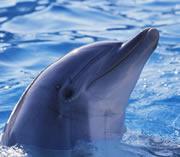-
les dauphins utiliseraient leurs dents pour optimiser leur écholocation
Better sonar through dolphin teeth
Dental arrays may be optimized for sound in shallow waters.Heidi Ledford


Smile: his pearly whites could help him find fish as well as eating them.
GettyA model of how dolphins may use their teeth to receive sound could provide clues for improving man-made sonar systems, according to a study published in Bioinspiration & Biomimetics1.
The results, says study author Peter Dobbins of the engineering firm SEA Group Ltd in Bristol, UK, could be particularly useful for improving sonar in shallow water, making it better at tasks such as searching for naval mines.
Dolphins use sonar for navigation and to echolocate prey by bouncing sound waves emitted as high-frequency clicks off objects in their environment. "Dolphins obtain a similar mental 'image' of the surface of a complex object whether they use sonar or vision to look at it," says Elizabeth Taylor, a marine biologist at the National University of Singapore.
Dolphin sonar outperforms any man-made system, particularly in shallow water, where reverberation, water turbulence and suspended sediment make sonar particularly challenging. To discover why dolphins are so adept at echolocating in shallow water, Dobbins devised models based on the theory that the animals receive some sounds using their teeth.
According to that theory, dolphin teeth act as an array of receivers that vibrate in response to pressure from sound waves. The notion helps explain two peculiarities in dolphin dentistry - dolphin teeth are all the same type, rather than being split into incisors for cutting and molars for chewing, and the distance between the teeth is remarkably precise. Dental vibration could be transmitted to the brain by specialized nerves, scientists have postulated, or to the jaw, which contains specialized fat deposits - sometimes called acoustic fat - believed to help transmit sound waves to the inner ear. It's just a wild hypothesis.
It's just a wild hypothesis. 
-
Commentaires
Mon petit cahier de sciences naturelles

